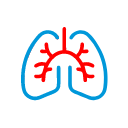Lungs
- Filtering waste products, excess water, and other impurities out of the blood.
- Regulating pH, salt, and potassium levels in the body.
- Regulating blood pressure and the production of red blood cells.
- Reduce salt intake: Too much salt can be harmful for people with kidney disease
- Activating a form of vitamin D that enhances calcium absorption.
Lungs Tests / Packages

Symptoms of Lungs Disease

Chronic cough that lasts longer

Shortness of breath after little or no exertion

Wheezing or noisy breathing

Chronic mucus
production

Chronic chest pain that lasts longer

Coughing up blood
What are the Main Causes of Lungs Disease?

Smoking Tobacco
It is the biggest cause of lung-related complaints.

Second Hand Smoke
It is especially bad for babies and young children.

Radon Gas
It is a recognized cause of lung cancer.

Air Pollution
It may contribute to asthma, COPD, lung cancer, and other lung diseases.

Chemicals
It can cause substantial damage to the lungs.

Allergies
Such as pollen, pet dander, insect waste, food allergens
Types of Common Lung Disease

Tuberculosis (TB)

Influenza (Flu)

Chronic obstructive pulmonary disease (COPD)

Lung Cancer

Cystic Fibrosis

Pneumonia

Asthma

Acute respiratory
distress syndrome
(ARDS)

Pulmonary Hypertension

Pulmonary Fibrosis
Tuberculosis (TB)
Tuberculosis (TB) is an airborne bacterial infection caused by the organism Mycobacterium tuberculosis that primarily affects the lungs, although other organs and tissues may be involved. It is most commonly seen in people with weakened immune systems.
TB is spread when a person with active, infectious TB disease coughs, sneezes, or spits, releasing droplets containing TB bacteria into the air, which are then inhaled by someone else. There are also forms of TB that are drug-resistant.
Pneumonia
Pneumonia is a common lung infection caused by germs, such as bacteria, viruses, and fungi. The infection causes the lungs air sacs to become inflamed and fill up with fluid or pus making it hard for the oxygen to get into the bloodstream. The symptoms of pneumonia can range from mild to severe and include cough, fever, chills, and trouble breathing. Infants and Young children, adults 65 or older, smokers, and people who are ill are at higher risk.
Influenza (Flu)
The flu is a respiratory infection caused by flu viruses. The viruses pass through the air and enter the body through the nose or mouth. The flu can also be acquired from contaminated surfaces. Symptoms of the flu are similar to those of the common cold, but they last longer and tend to be worse.
- Influenza Type A: There are different strains of influenza type A viruses, two of which circulate among humans, H1N1 and H3N2.
- Influenza Type B: It can cause illness among humans but are associated with less severe infection than influenza A viruses.
- Influenza Type C: It causes mild illness in humans and cases occur much less frequently than A and B.
- Avian flu (H5N1): Also known as bird flu, is a subtype of influenza type A viruses. The virus is mainly transmitted to humans by direct contact with infected live, sick or dead poultry.
Asthma
Asthma is the most common chronic lung condition. Asthma attacks happen when the airways tighten and narrow, slowing down airflow. The lungs also become swollen and inflamed.
Asthma can be triggered by an allergic reaction, pollution, exercise, other respiratory illness, and cold air. The symptoms of Asthma often present in periodic attacks or episodes of tightness in the chest, wheezing, breathlessness, and coughing.
Chronic obstructive pulmonary disease (COPD)
COPD is an umbrella term used to describe progressive lung diseases including Chronic bronchitis, Emphysema, Refractory (non-reversible) Asthma. This disease is characterised by increasing breathlessness. The bronchial tubes become inflamed and scarred in Chronic bronchitis whereas the air sacs in the lungs are slowly destroyed in the case of Emphysema. It may be caused by smoking, air pollution, chemicals, or a genetic condition.
Acute respiratory distress syndrome (ARDS)
ARDS is a condition that causes fluid to leak into the lungs, blocking oxygen from getting to the organs. It occurs when there is trauma to the lungs e.g. sepsis, severe pneumonia. It is a serious condition and can be life-threatening.
Lung Cancer
Lung Cancer is the uncontrolled growth of malignant cells that originate in the lungs.
- Small cell lung cancer: It occurs almost exclusively in heavy smokers and is less common than non-small cell lung cancer.
- Non-small cell lung cancer: It is an umbrella term for several types of lung cancers that behave similarly. Non-small cell lung cancers include squamous cell carcinoma, adenocarcinoma and large cell carcinoma.
Pulmonary Hypertension
Pulmonary hypertension occurs when there is abnormally high pressure in the blood vessels between the lungs and the heart. Pulmonary hypertension can be acquired as a result of other medical conditions such as heart disease, lung disease, or connective tissue disease. If no cause can be identified, the condition is called idiopathic pulmonary arterial hypertension.
Pulmonary Embolism
This condition occurs when a blood clot gets caught in one of the arteries that go from the heart to the lungs and blocks the normal blood flow causing chest pain, acute shortness of breath, and coughing. It can be life-threatening and requires prompt medical attention.
Cystic Fibrosis
Cystic fibrosis is an inherited and life-threatening disease that causes thickened mucus to form in the lungs, pancreas and other organs. In the lungs, this mucus blocks the airways, causing lung damage and making it hard to breathe.
Pulmonary Fibrosis
Pulmonary fibrosis is a lung disease characterised by damage and scarring to the tissues of the lungs, including those between and supporting the air sacs. Causes of Pulmonary Fibrosis can be -
- Inhaling hazardous chemicals
- Chemicals and drugs that are toxic to the lungs Previous Radiation Treatment
- Certain medical conditions e.g. Sarcoidosis, Scleroderma
- Unknown (Idiopathic Pulmonary Fibrosis)
How is Lung Disease Diagnosed?
Chest X-Ray
It is used by doctors to check lung structure and chest cavity. An X-ray will show areas of the lung that are clogged up or scarred.
CT Scan
CT Scan provides a more detailed evaluation of lung structure.
Chest Ultrasound
Chest Ultrasound is used to detect any fluid buildup in or around the lungs. It uses high frequency sound waves to provide a detailed image of the lungs
Blood Gas Analysis, Arterial
This test is used to evaluate lung function by measuring blood pH, Oxygen, Carbon Dioxide.
Complete Blood Count (CBC)
CBC is a series of tests that measure red blood cells, white blood cells and platelets.
Immunoglobulin IgE
It is used to establish the diagnosis of an allergy and to define the allergens responsible for eliciting signs and symptoms. It may be ordered to determine asthma triggers.
Mantoux Test; Tuberculin Skin Test
This test is used to screen for tuberculosis (TB) active or latent infection. A positive test result means that the person is likely to have been exposed to TB and the person may have a latent or activeTB infection.
Interferon Gamma Release Assay (IGRA)
This test is used to screen for tuberculosis (TB) active or latent infection. It measures how stronglya person's immune system reacts to specific TB antigens.
Spirometry
This test measures the airflow into the lungs. It is used to evaluate narrowed or obstructed airways.
Oximetry
This test measures the oxygen levels in the blood. The purpose of pulse oximetry is to check how well the heart is pumping oxygen through the body.
Sputum Culture
Sputum Culture is used to detect and diagnose bacterial lower respiratory tract infections such as Pneumonia, Bronchitis.
Tips for Healthy Lungs

Quit Smoking

Minimise exposure to outdoor air pollution

Get regular aerobic exercise

Maintain good oral hygiene

Avoid secondhand
smoke

Improve Indoor Air

See a doctor regularly to get health checkups

Get vaccinated against the flu and pneumonia

Don't chew tobacco

Avoid exposure to
indoor pollutants

Wash your hands often with soap and water

Improve Indoor Air
The lungs work with the heart to oxygenate blood. They do this by filtering the air a person breathes, then removing excess carbon dioxide in exchange for oxygen.
Several parts of the lungs help the body take in air, filter it, and then oxygenate the blood. These are:
- The left and right bronchi:The trachea splits into these tubes, which extend into the lungs and have branches. These smaller bronchi split into even smaller tubes called bronchioles.
- The alveoli: The alveoli are tiny air sacs at the end of the bronchioles. They work like balloons, expanding when a person inhales and contracting when they exhale.
- The blood vessels: There are numerous blood vessels in the lungs for carrying blood to and from the heart.
With extensive medical care, a person can live without one lung, but they cannot survive with no lungs.
The diaphragm, which is a thick band of muscle directly under the lungs, helps the lungs expand and contract when a person breathes.




















